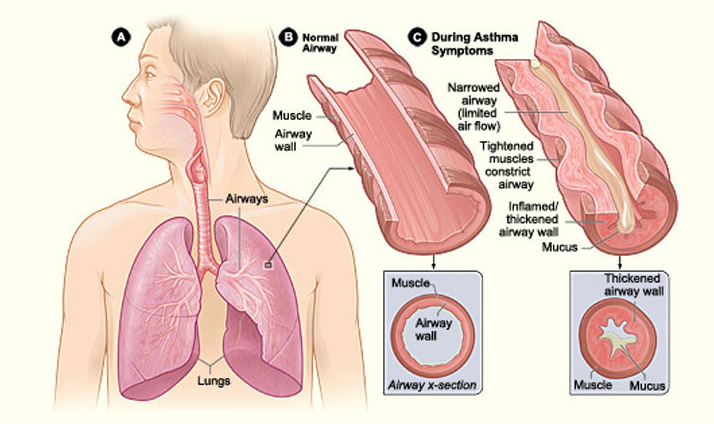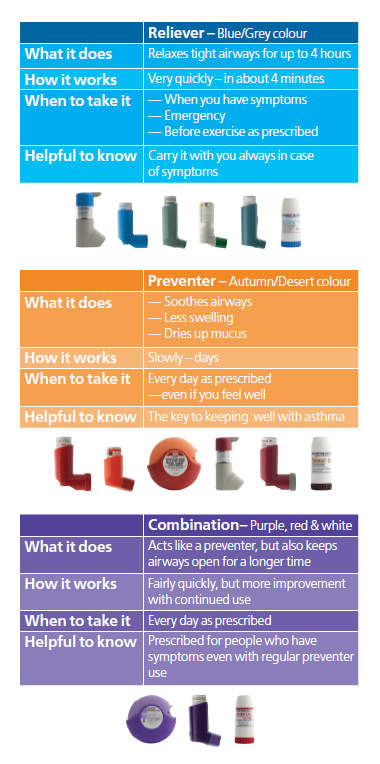It was World Asthma Day on May 6, and that got us to thinking about understanding Asthma and the role community pharmacy plays in helping people manage the disease.
So what is asthma?
Asthma is a long term chronic disease of the airways, the small tubes that carry air in and out of the lungs – you may also know them as bronchioles.
For people with asthma, wheezing (high-pitched sound coming from the chest while breathing), shortness of breath, tightening of the muscles around the airways, coughing and extra mucus are regular issues. When someone is having an asthma attack, the muscle wall contracts and the lining of the airways becomes swollen and inflamed. This causes a narrowing of the airways and the production of more mucus, which in turn leads to blocked airflow.
There are around 2 million Australians with asthma – 1 in 10 adults and 1 in 9 children. Even if a person didn’t have asthma as a child, they can still develop the disease later in life and the reverse is also true – children with asthma can have few or no symptoms as an adult.
The causes
While the underlying causes of asthma are still not fully understood, there is a link between asthma and those with a family history of asthma, eczema and hay fever. Lifestyle and environment factors, such as workplace chemicals, air pollution and tobacco smoke, can also lead to asthma.
Management
There is no cure for asthma, but with proper management it can be kept at bay.
- Removing environmental triggers from the person’s home/work can make a big difference. Recommend to your customer that they look into removing dust mites, pets, moulds, pollens, cigarette smoke, wood dust, chemicals and metal salts.
- Colds and influenza – recommend to you customer that they should get an annual flu vaccine and lung health check.
- Some medicines, including non-steroidal anti-inflammatory drugs and aspirin, can act as triggers. Always check with the pharmacist to ensure there won’t be any contraindications.
- Exercise – recommend to your customer that warming up is important, as is aiming to breathe through your nose and keeping up a good level of fitness.
- Cold weather – remind your customer to use prescribed medication as recommended.
- Stress and high emotions are often hard to avoid, but telling your customer to keep these in mind will assist in keeping their symptoms under control.
Medication
There are a number of medication categories when it comes to managing asthma. These include symptom relievers, preventers and combination medicines. It is important for asthma sufferers to follow the directions of their doctor and pharmacist, so having this information handy to support customers in using their medications correctly is important.
Using devices
Using asthma inhalers properly can be tricky for some, so it is important that all adults and children receive training from health professionals, in many cases the pharmacist. Supporting customers who need to use an inhaler and spacer is important. Take a look at the National Asthma Council Australia website for a range of instructional videos.
How can you help in emergency?
| Mild/Moderate | Severe | Life-threatening | |
| Symptoms | · Minor difficulty breathing · Able to talk in full sentences · Able to walk/move around · May have cough or wheeze |
· Obvious difficulty breathing · Cannot speak a full sentence in one breath · Tugging in of the skin between ribs or at base of neck · May have cough or wheeze · Reliever medication not lasting as long as usual |
· Gasping for breath · Unable to speak or 1-2 words per breath · Confused or exhausted · Turning blue · Collapsing · May no longer have wheeze or cough · Not responding to reliever medication |
| What you can do | Ask the person if they have asthma and if they need help. If so, assist the person with Asthma First Aid. | · Call Ambulance on 000 · Commence Asthma First Aid |
· Call Ambulance on 000 · Commence Asthma First Aid |
Asthma First Aid
1. Sit the person upright
- Be calm and reassuring
- Do not leave them alone
2. Give 4 separate puffs of blue/grey reliever puffer
- Shake puffer
- Put 1 puff into spacer
- Take 4 breaths from spacer
- Repeat until 4 puffs have been taken
- Remember: Shake, 1 puff, 4 breaths
3. Wait 4 minutes
- If there is no improvement, give 4 more separate puffs of blue/grey reliever as above
4. If there is still no improvement call emergency assistance (DIAL OOO)
- Say ‘ambulance’ and that someone is having an asthma attack
- Keep giving 4 separate puffs every 4 minutes until emergency assistance arrives
- Important note: if calling Triple Zero (000) does not work on your mobile phone, try 112.
Call emergency assistance immediately (DIAL 000) if:
- The person is not breathing
- The person’s asthma suddenly becomes worse, or is not improving
- The person is having an asthma attack and a reliever is not available
- You are not sure if it’s asthma
- The person is known to have Anaphylaxis – follow their Anaphylaxis Action Plan, then give Asthma First Aid.
Note: Blue/grey reliever medication is unlikely to harm, even if the person does not have asthma
Sources:
SIRCHCS303 Advise on asthma management – unit available individually or as part of the Certificate III in Community Pharmacy.
Australian Asthma Handbook
Asthma Australia
National Asthma Council Australia
Think you know your stuff? Test out your knowledge on this month’s Brain Tweezers!


